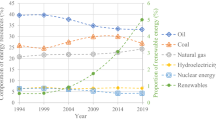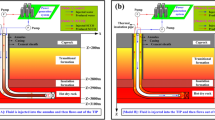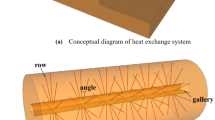Abstract
Optimizing the heat extraction performance of geothermal systems is a long-standing issue in the study of geothermal energy. Besides the heat extraction in fractured hot rock, minimizing the heat loss during water flowback through boreholes is also critical for the system performance. Here, we conducted a series of experimental and numerical studies to understand the controlling factors of heat extraction rate and efficiency and to explore practical approaches for the optimization of heat extraction performance in a geothermal borehole. We performed water flow experiments to observe the heat extraction from neighboring hot granite and reproduced the heat extraction process using a three-dimensional water flow model. Our results show that the heat extraction rate first increases with a higher flow rate to the maximum value and then decreases with a further rise in flow rate. The heat extraction efficiency decreases constantly with a higher flow rate. To improve the heat extraction performance with both the heat extraction rate and efficiency approaching the maximum values, we scaled up the laboratory-scale borehole and found that the heat extraction performance is enhanced with a triangular zone of heat extraction and a reduced zone of low-temperature water along a field-scale borehole. We finally discovered that a proper control of borehole geometry, such as section diameters along a multi-section borehole and bending angle of borehole trajectory, is a feasible strategy to modulate the heat extraction performance in a geothermal borehole and to replenish the heat loss during water flowback.
Highlights
-
Experimental and numerical studies are conducted to understand the controlling factors of heat extraction rate and efficiency.
-
Heat extraction performance is enhanced with a triangular zone of heat extraction and a reduced zone of low-temperature water.
-
Multi-section borehole is a feasible strategy to modulate the heat extraction performance in a geothermal borehole.
-
Proper bending angle of borehole trajectory is another feasible strategy to optimize the heat extraction performance.











Similar content being viewed by others
Data availability
Data is available upon request.
References
Barbier E (2002) Geothermal energy technology and current status: an overview. Renew Sustain Energy Rev 6:3–65
Borgia A, Pruess K, Kneafsey TJ, Oldenburg CM, Pan L (2012) Numerical simulation of salt precipitation in the fractures of a CO2-enhanced geothermal system. Geothermics 44:13–22
Chen Y, Zhao Z (2020) Heat transfer in a 3D rough rock fracture with heterogenous apertures. Int J Rock Mech Min Sci 134:104445
Cui P, Yang H, Fang Z (2006) Heat transfer analysis of ground heat exchangers with inclined boreholes. Appl Therm Eng 26:1169–1175
Davis AP, Michaelides EE (2009) Geothermal power production from abandoned oil wells. Energy 34:866–872
Gan Q, Elsworth D (2016) Production optimization in fractured geothermal reservoirs by coupled discrete fracture network modeling. Geothermics 62:131–142
Gao J, Shi Q (2021) A new mathematical modeling approach for thermal exploration efficiency under different geothermal well layout conditions. Sci Rep 11:22930
Harris BE, Lightstone MF, Reitsma S (2021) A numerical investigation into the use of directionally drilled wells for the extraction of geothermal energy from abandoned oil and gas wells. Geothermics 90:101994
Hosein R, Serrattan S, Jupiter A (2019) The viability of slim-hole drilling onshore Trinidad. J Pet Explor Prod Technol 9:1307–1322
Hu J, Xie H, Gao M, Li C, Sun Q (2022) Damage mechanism and heat transfer characteristics of limestone after thermal shock cycle treatments based on geothermal development. Int J Rock Mech Min Sci 160:105269
Huang Y, Kong Y, Cheng Y, Zhu C, Zhang J, Wang J (2023) Evaluating the long-term sustainability of geothermal energy utilization from deep coal mines. Geothermics 107:102584
Jäckel R, Gutiérrez Urueta GL, Tapia Rodríguez F, Monreal Jiménez C (2019) Numerical and experimental characterisation of an aeronautic Pitot probe. Aeronaut J 123:890–891
Ji Y, Wang L, Zheng Y, Wu W (2021) Temperature-dependent abrasivity of Bukit Timah granite and implications for drill bit wear in thermo-mechanical drilling. Acta Geotech 16:885–893
Kang F, Li Y, Tang C, Huang X, Li T (2022) Competition between cooling contraction and fluid overpressure on aperture evolution in a geothermal system. Renew Energy 186:704–716
Lei Z, Zhang Y, Zhang S, Fu L, Hu Z, Yu Z, Li L, Zhou J (2020) Electricity generation from a three-horizontal-well enhanced geothermal system in the Qiabuqia geothermal field, China: slickwater fracturing treatments for different reservoir scenarios. Renew Energy 145:65–83
Li T, Tang C, Rutqvist J, Hu M (2021) TOUGH-RFPA: Coupled thermal-hydraulic-mechanical Rock Failure Process Analysis with application to deep geothermal wells. Int J Rock Mech Min Sci 142:104726
Li G, Ji J, Song X, Shi Y, Li S, Song Z, Song G, Xu F (2022) Research advances in multi-field coupling model for geothermal reservoir heat extraction. Energy Rev 1:100009
Li X, Li C, Gong W, Zhang Y, Wang J (2023) Probabilistic analysis of heat extraction performance in enhanced geothermal system based on a DFN-based modeling scheme. Energy 263:125674
Liu G, Zhao Z, Xu H, Zhang J, Kong X, Yuan L (2022) A robust assessment method of recoverable geothermal energy considering optimal development parameters. Renew Energy 201:426–440
Marcotte D, Pasquier P (2009) The effect of borehole inclination on fluid and ground temperature for GLHE systems. Geothermics 38:392–398
Mohammed HA (2009) The effect of different inlet geometries on laminar flow combined convection heat transfer inside a horizontal circular pipe. Appl Therm Eng 29:581–590
Pandey SN, Vishal V (2017) Sensitivity analysis of coupled processes and parameters on the performance of enhanced geothermal systems. Sci Rep 7:17057
Pandey SN, Vishal V, Chaudhuri A (2018) Geothermal reservoir modeling in a coupled thermo-hydro-mechanical-chemical approach: a review. Earth-Sci Rev 185:1157–1169
Phuoc TX, Massoudi M, Wang P, McKoy ML (2019) Heat losses associated with the upward flow of air, water, CO2 in geothermal production wells. Int J Heat Mass Transf 132:249–258
Rathnaweera TD, Wu W, Ji Y, Gamage RP (2020) Understanding injection-induced seismicity in enhanced geothermal systems: from the coupled thermo-hydro-mechanical-chemical process to anthropogenic earthquake prediction. Earth-Sci Rev 205:103182
Rossi E, Jamali S, Wittig V, Saar MO, von Rohr PR (2020) A combined thermo-mechanical drilling technology for deep geothermal and hard rock reservoirs. Geothermics 85:10177
Shu B, Wang Y, Zhu R, Liu L, Tan J, Dick J (2022) Experimental study of the heat transfer characteristics of single geothermal fracture at different reservoir temperature and in situ stress conditions. Appl Therm Eng 207:118195
Sun Z, Jiang C, Wang X, Lei Q, Jourde H (2020) Joint influence of in-situ stress and fracture network geometry on heat transfer in fractured geothermal reservoirs. Int J Heat Mass Transf 149:119216
Sun Z, Jiang C, Wang X, Zhou W, Lei Q (2021) Combined effects of thermal perturbation and in-situ stress on heat transfer in fractured geothermal reservoirs. Rock Mech Rock Eng 54:2165–2181
Talalay PG, Hong J (2021) Perspectives for development of ice drilling technology: continuation of the discussion. Ann Glaciol 62:143–156
Tritton DJ (1977) Physical fluid dynamics. Van Nostrand Reinhold Company Ltd
Wang J, Xu P, Li T, Zhu J (2017) Performance enhancement of organic Rankine cycle with two-stage evaporation using energy and exergy analyses. Geothermics 65:126–134
Xu F, Shi Y, Song X, Li G, Song Z, Li S (2023) The characteristics and laws of fracture damage in the long-term production process of high-temperature geothermal resources. Rock Mech Rock Eng 56:275–299
Zeng YC, Wu NY, Su Z, Wang XX, Hu J (2013) Numerical simulation of heat production potential from hot dry rock by water circulating through a novel single vertical fracture at Desert Peak geothermal field. Energy 63:268–282
Zhang L, He J, Wang H, Cen X (2022) Study on heat extraction characteristics in a rock fracture for the application of enhanced geothermal systems. Geothermics 106:102563
Zhao Y, Liu L, Wen D, Zhang B, Zhang X, Huan C, Wang M, Wang X (2022) Experimental study of horizontal ground heat exchangers embedded in the backfilled mine stopes. Geothermics 100:102344
Acknowledgements
This research is supported by the National Research Foundation, Singapore, under its Intra-CREATE Thematic Grant (Award No. NRF2019-THE001-0002).
Funding
Funding was provided by National Research Foundation Singapore (Grant number: NRF2019-THE001-0002).
Author information
Authors and Affiliations
Corresponding author
Ethics declarations
Conflict of interest
The authors declare no conflict of interest.
Additional information
Publisher's Note
Springer Nature remains neutral with regard to jurisdictional claims in published maps and institutional affiliations.
Rights and permissions
Springer Nature or its licensor (e.g. a society or other partner) holds exclusive rights to this article under a publishing agreement with the author(s) or other rightsholder(s); author self-archiving of the accepted manuscript version of this article is solely governed by the terms of such publishing agreement and applicable law.
About this article
Cite this article
Lu, D., Wu, W. Controlling Borehole Geometry as a Feasible Strategy for Optimization of Heat Extraction in Geothermal Systems. Rock Mech Rock Eng (2024). https://doi.org/10.1007/s00603-024-03931-5
Received:
Accepted:
Published:
DOI: https://doi.org/10.1007/s00603-024-03931-5




